|
Pocket Stars Smartphone is a high accuracy star chart and guide to the heavens for Windows Mobile Smartphones. Based on the award winning version for Pocket PC's, Pocket Stars Smartphone combines rich capabilities with simple and quick navigation.
 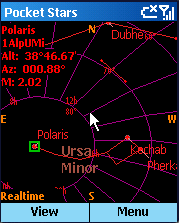 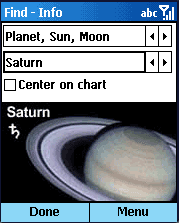
  
|
Current Version: 2.2.4
Released 17 Apr 2004
| Try / Buy from an authorized distributor by clicking one of the images below:



|



|
-
Designed for Windows Mobile Logo Certified by QualityLogic
-
Binary is signed by GeoTrust
-
Runs on all Smartphone 2002
devices and above.
-
Free upgrades for Registered Users
-
Money Back Guarantee
If you're not delighted with
Pocket Stars SP, we offer a
no-quibble refund within 30 days
of purchase.

|
|
Star ChartFeatures
-
9110 stars
-
Constellations
-
Solar system bodies
-
Messier and Caldwell Objects
-
Display of orbital paths for inner solar system bodies showing daily positions for one year centered on current date.
-
Manual or automatic control of star magnitudes. Simple control over which objects to display. Overall, these features give great control of visual clutter given the limited screen real estate on the Smartphone.
-
Black, white, and red star chart colors for normal, bright, and night viewing conditions, respectively.
-
Chart can be rotated to any of the 8 compass points and also flipped along the North - South axis. This allows the either overhead (East and West reversed) or non-overhead (East and West normal) viewing.
-
Polar grid with hour angle and declination labels.
-
Zenith grid.
-
Search and scroll to constellation, body, star, or Messier / Caldwell objects.
-
User location set by city selection, or by entering Latitude and Longitude.
-
Star data is from the Bright Star Catalog (5th Revised Edition), comprising the 9110 brightest stars using J2000 equatorial positions and the International Celestial Reference Frame (ICRF). Corrections are performed for proper motions and parallax.
-
Planet ephemeris data from Jet Propulsion Laboratory using the DE405 database. DE405 is JPL's latest planetary ephemeris with correction for both nutations and librations. DE405 uses the J2000 International Celestial Reference Frame (ICRF). The portion of this database provided with Pocket Stars covers the years CE 2000 to CE 2020. Other ephemeris date ranges are available for download here.
-
Core positional calculation routines based on "Novas" (Naval Observatory Vector Astrometry Subroutines Version 2.0.1).
Other Features
-
Rise, set, and meridian times for all solar system bodies.
-
Lunar Phase calendar and animation showing the relative positions of the earth, moon, and sun.
-
Images and physical data for planets, moon and sun. Optional display of all 110 Messier objects through separate free download.
Operating Manual
|
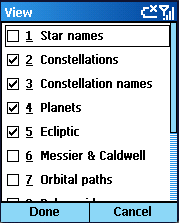 |
|
The Left soft button displays the "View" dialog.
Either scroll or use the number keys to choose which objects and overlays to display.
1 Star Names
2 Constellations
3 Constellation Names
4 Planet Names
5 Ecliptic The ecliptic is the great circle on the celestial sphere that lies in the plane of the earth's orbit.
6 Messier Displays and hides the 110 Messier and 109 Caldwell deep space objects.
7 Orbital Paths Displays and hides the paths for the inner solar system bodies. The paths are draw for one year, centered on the current star chart date.
8 Polar Grid. Displays and hides a grid through the north and south celestial poles.
9 Zenith Grid. Displays and hides a grid centered on the zenith point of the observer.
0 None. Hides all of the above objects.
* Show Info. Show and hide information on the selected object.
# Show Time. Show and hide the date and time.
|
|
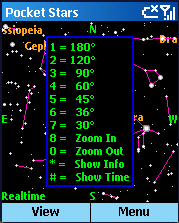 |
|
The OK/Action button shows the key menu for Zooming. Click it again to hide the menu.
You can quickly change to various zoom factors by hitting a number key, or zoom smoothly in and out. The most important keys are:
8 Zoom In
0 Zoom Out
|
Main Menu
|
 |
|
Location
Controls the zenith point used when drawing the star chart. You can either select a city from the list or enter the latitude and longitude manually. The first entry in the Cities list is "Custom" and is automatically selected if the latitude or longitude fields are manually changed.
|
|
 |
|
Time
Controls the time at which the star chart is valid above the selected Location.
Realtime. If checked, continuously update the star chart with the current Smartphone time. If unchecked, you may specify a particular time using the date and time fields.
UTC. If checked, the time selected is in Coordinated Universal Time (UTC). Otherwise, time is entered as local time using the offset from UTC established by the following fields.
Time Zone. Time Zone specifies the how local time differs from UTC, expressed in hours. Each time zone covers 15° of longitude. Locations west of Greenwich have negative offsets, while locations east of Greenwich have positive offsets. The time zone may be set using three different methods:
System - Uses the time zone established by the device clock. This is controlled by "Start.Settings.Date and Time".
Longitude - Uses the current geographical location (specified in the Location page) to calculate Zone Time. While correct for many locations, this method does not take into account the effect of political boundaries.
Custom - Enables a list box which you can use to set the Time Zone.
DST. If checked, indicates Daylight Savings Time is in effect.
|
|
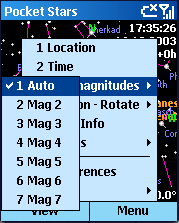 |
|
Star Magnitudes
Controls the minimum brightness of stars displayed on the chart.
Auto reduces screen clutter by automatically adjusting the number of stars displayed appropriate to the zoom setting. Otherwise, the number of stars displayed depends on the magnitude selected:
| Magnitude |
Number of Stars |
| 0 |
4 |
| 1 |
15 |
| 2 |
48 |
| 3 |
170 |
| 4 |
513 |
| 5 |
1604 |
| 6 |
5023 |
| 7 |
9046 |
| 8 |
9096 |
|
|
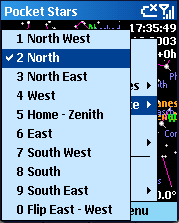 |
|
Horizon - Rotate
Positions any of the 8 compass points at the top of the chart. Also allows reversal of east and west.
Home - Zenith Remove all scrolling effects so that the stars directly overhead are positioned at the center of the display. Zoom factor is set to 1.5. Note that a green X marks the zenith point directly overhead.
Flip East and West. If checked, the star chart is flipped along the North - South axis. Leave this option unchecked if viewing the computer display in-line with the sky. For example, leave this option unchecked if lying on your back with the screen overhead. If checked, the display is mirrored along the North - South axis, switching the positions of East and West.
|
|

|
|
Find - Info
Used to select a star, planet, sun, moon, constellation, or Messier and Caldwell object. The selected object will be centered on the star chart if the "Center on Chart" checkbox is selected. An image of the object is displayed if available.
Note that free Messier and Caldwell image files can be downloaded from this page. Select the ARM processor.
|
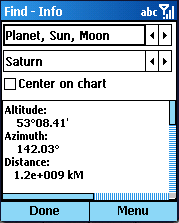 |
|
The "Info" menu choice switches to a detailed listing of measured and calculated values pertaining to the body. |
|
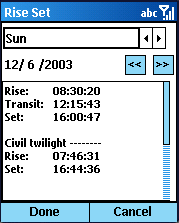
|
|
Events, Rise and Set
Displays the rise, transit, and set times for all solar system bodies.
When Sun is selected, also displays civil, nautical, and astronomical twilight.
Use the left and right arrows to increment and decrement by one day.
|
|
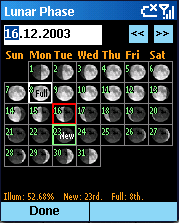
|
|
Events, Lunar Phase
Displays the phases of the moon for a selected month. The full, new, (and blue if available) dates are shown.
Illumination percentage for the selected date is shown at the bottom of the dialog.
Use the left and right arrows to increment and decrement by one day.
|
|
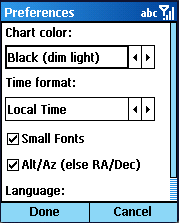 |
|
Preferences
Controls display options for the primary star chart.
Star chart color
-
Black (best in dim ambient light). If checked, the star chart background is black.
-
White (best in bright ambient light). If checked, the star chart background color is white.
-
Red (preserve night vision). If checked, the display colors are changed to shades of red to cause minimal loss of night vision.
Star chart Time format Controls how time is displayed in the upper right corner of the star chart. Use the "#" key to toggle display of time.
-
Local Time. The full time and date will be displayed.
-
Local Sidereal Time. The abbreviation "LST" will appear under the time.
-
UTC. The abbreviation UTC will appear under the time.
-
Greenwich Mean Sidereal Time. The abbreviation "GMST" will appear under the time.
Small Fonts. If checked, a smaller font is used for displaying information on the star chart.
Alt/Az (else RA/DEC). If checked, Altitude and Azimuth are displayed on the main star chart. Otherwise, right ascension (RA) and declination (Dec) are displayed.
|
|
 |
|
Help, Registration
Displays a dialog to enter the registration code.
If you have an internet connection, press the "Click to purchase online" to visit a website to purchase a registration code.
|
|
 |
|
Help, About
Displays the version number of Pocket Stars and accesses this help screen.
|
Additional hints
- A Green X is used to mark the zenith point directly overhead.
- Use the * to show and hide the name, identifier, coordinates, and magnitude of the selected object in the upper left corner.
- Use the # to show and hide the star chart time in the upper right corner.
|

 
  
Pocket Stars Smartphone runs on all Windows Mobile Smartphones.

FastCounter by bCentral
|